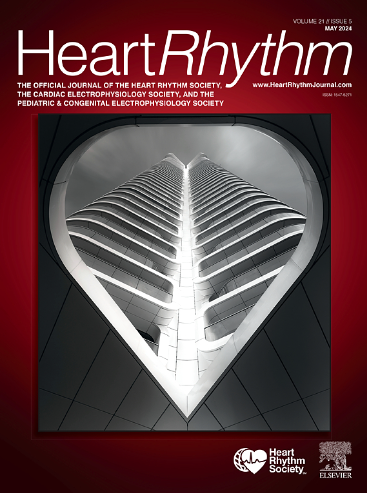新诊断为心房颤动和既往诊断为心房颤动的亚洲患者的临床结局:来自 CODE-AF 登记的启示。
IF 5.6
2区 医学
Q1 CARDIAC & CARDIOVASCULAR SYSTEMS
引用次数: 0
摘要
背景:心房颤动(房颤)在早期阶段可能具有不同的临床特征:本研究通过大型多中心前瞻性登记(房颤症状控制和并发症预防药物比较研究[CODE-AF])比较了早期房颤与晚期房颤的特征和临床结果:根据房颤持续时间将2016年6月至2021年3月期间入组的患者分为两组:(1)新诊断患者(房颤持续时间≤90天)和(2)既往诊断患者(房颤持续时间>90天)。对两组的基线特征和临床结果进行了比较:在 10 001 名研究参与者(平均年龄为 67.0±14.5 岁,64% 为男性)中,22% 为新诊断患者,78% 为既往诊断患者。新诊断的患者合并症较少,不健康的社会行为较多。尽管口服抗凝剂的处方率较低,但直接口服抗凝剂的使用频率更高。新诊断组在90天内的综合临床结果风险也更高(调整后HR为1.81,95% CI为1.30-2.53,PConclusions:早期房颤患者更年轻,合并症更少。虽然心衰入院和轻微出血的风险较高,但死亡、中风和大出血的风险并未显著增加。为了应对这些风险,在最初几个月进行有序的监测和管理至关重要。本文章由计算机程序翻译,如有差异,请以英文原文为准。

Clinical outcomes of Asian patients with newly diagnosed atrial fibrillation and previously diagnosed atrial fibrillation: Insights from the CODE-AF Registry
Background
Atrial fibrillation (AF) may have different clinical features in its early phase.
Objective
The purpose of this study was to compare the characteristics and clinical outcomes of early-phase AF with later-phase AF using a large multicenter prospective registry (CODE-AF [COmparison study of Drugs for symptom control and complication prEvention of Atrial Fibrillation]).
Methods
Patients enrolled between June 2016 and March 2021 were divided into 2 groups based on AF duration: (1) newly diagnosed (AF duration ≤90 days); and (2) previously diagnosed (AF duration >90 days). Baseline characteristics and clinical outcomes were compared.
Results
Among the 10,001 study participants (mean age 67.0 ± 14.5 years; 64% men), 22% were defined as newly diagnosed and 78% as previously diagnosed. Newly diagnosed patients had fewer comorbidities and more unhealthy social behaviors. Despite lower prescription rates of oral anticoagulant, direct oral anticoagulants were more frequently used. The newly diagnosed group also had a higher composite clinical outcome risk within 90 days (adjusted hazard ratio 1.81, 95% confidence interval 1.30–2.53, P <.001) and revealed a higher risk of all bleeding and heart failure admission within 90 days. No significant differences remained between the groups over 36-month follow-up.
Conclusion
Patients with early-stage AF were younger and had fewer comorbidities. Although there was a higher risk of heart failure admissions and minor bleeding, the risks of death, stroke, and major bleeding were not significantly increased. Structured monitoring and management during the initial months are essential to address these risks.
求助全文
通过发布文献求助,成功后即可免费获取论文全文。
去求助
来源期刊

Heart rhythm
医学-心血管系统
CiteScore
10.50
自引率
5.50%
发文量
1465
审稿时长
24 days
期刊介绍:
HeartRhythm, the official Journal of the Heart Rhythm Society and the Cardiac Electrophysiology Society, is a unique journal for fundamental discovery and clinical applicability.
HeartRhythm integrates the entire cardiac electrophysiology (EP) community from basic and clinical academic researchers, private practitioners, engineers, allied professionals, industry, and trainees, all of whom are vital and interdependent members of our EP community.
The Heart Rhythm Society is the international leader in science, education, and advocacy for cardiac arrhythmia professionals and patients, and the primary information resource on heart rhythm disorders. Its mission is to improve the care of patients by promoting research, education, and optimal health care policies and standards.
 求助内容:
求助内容: 应助结果提醒方式:
应助结果提醒方式:


